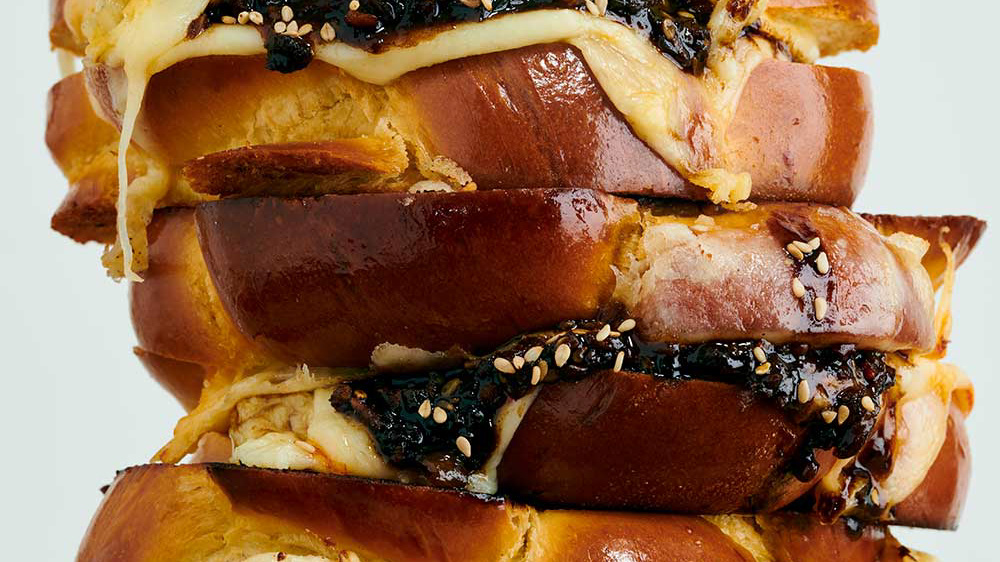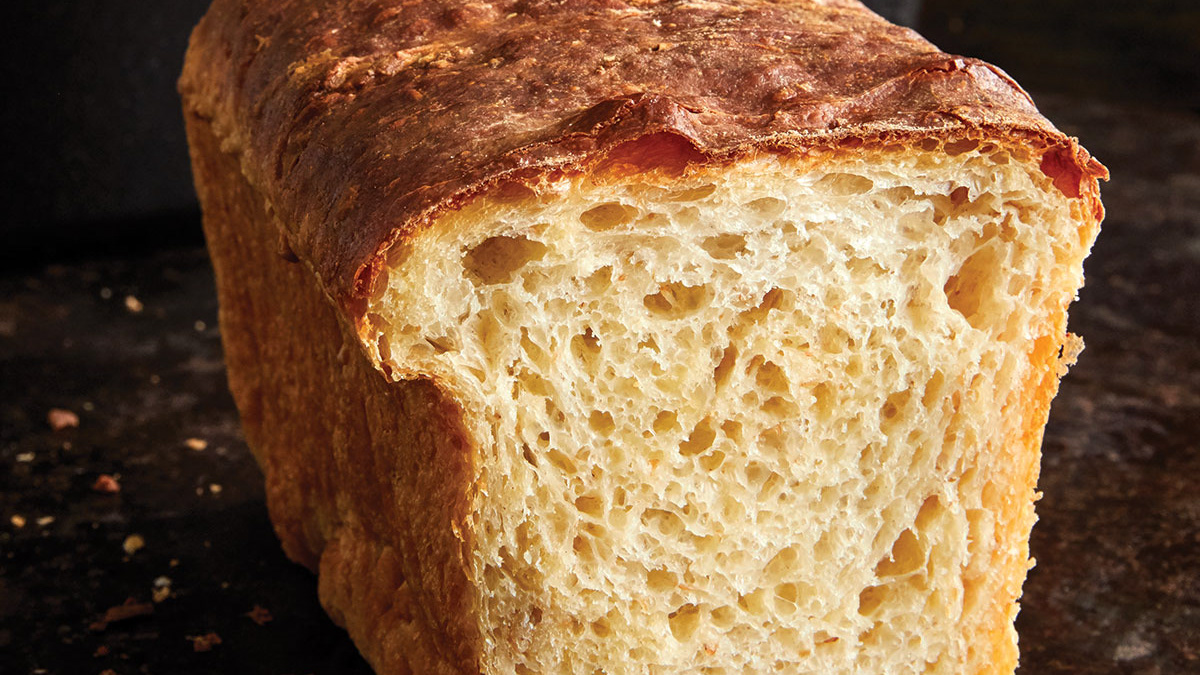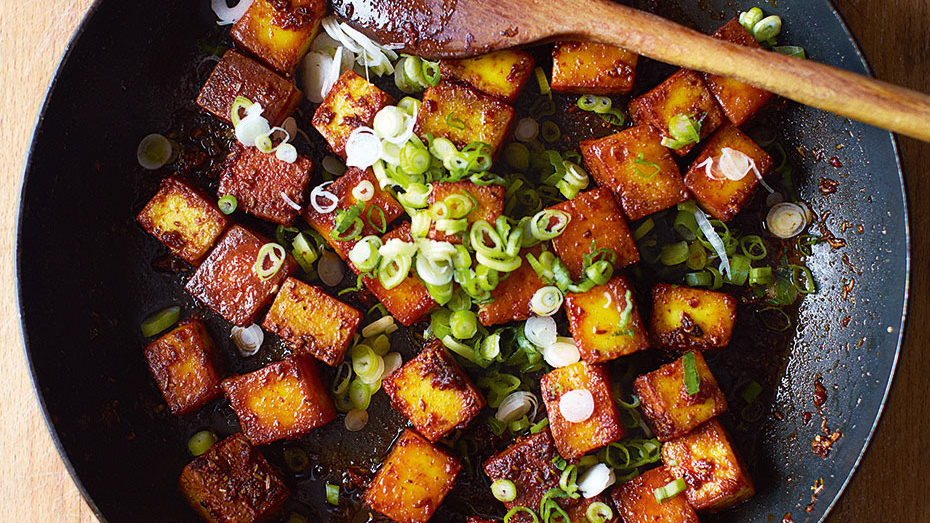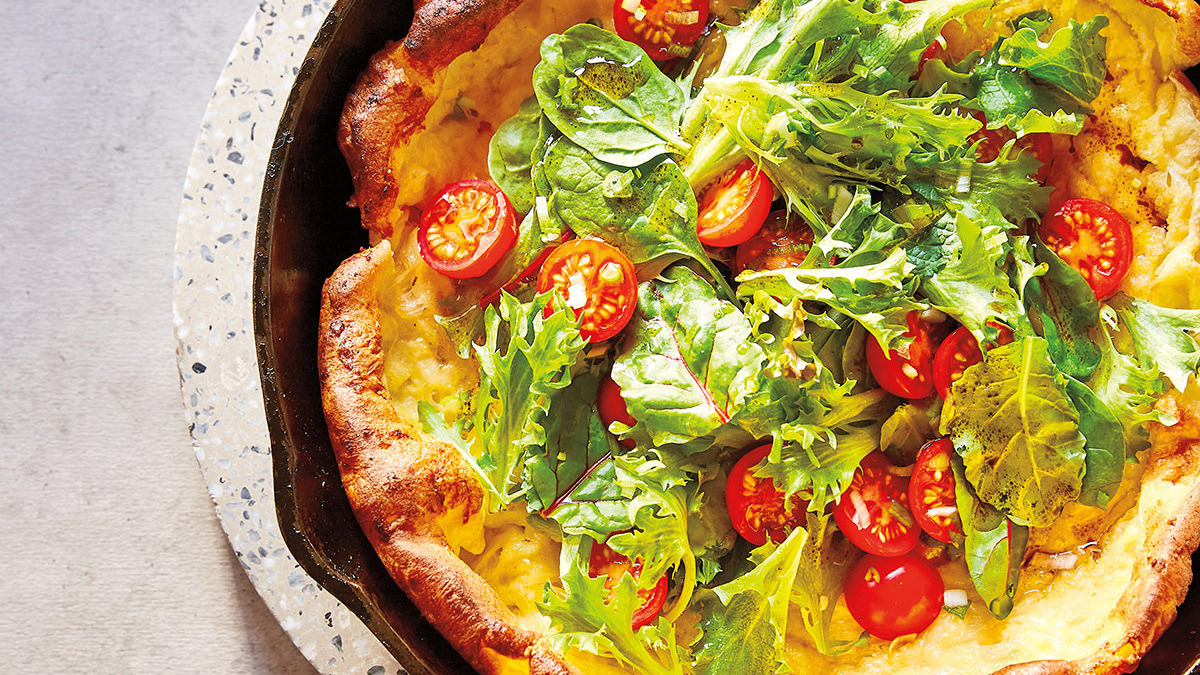PHOTO: Nawal Nasrallah/McGill-Queen’s University Press; Za'atar, left, and sumac.
Laura Brehaut/Postmedia News
Originally published on September 18, 2013; canada.com
Originally published on September 18, 2013; canada.com
Turkey, Iran, Iraq – where did the kebab, now enjoyed the world over, originate? As Iraqi scholar and food writer Nawal Nasrallah will tell you, Iraq’s claim to the kebab goes back to ancient Mesopotamian times. “In ancient Akkadian kababu meant ‘to grill’ or ‘to burn fire or wood,’” she says. “The medieval Arabic meaning is from kabba ‘lay meat on the fire.’”
Nasrallah explores the historical and cultural aspects of Iraqi cuisine in her book Delights from the Garden of Eden: A Cookbook and History of the Iraqi Cuisine (McGill-Queen’s University Press; 2nd edition, 2013). This dense volume, which draws on the nation’s literature, poetry, folklore, songs and stories, was truly a labour of love for Nasrallah, who immigrated to the United States in 1990.
Settling in a new country, she often faced questions about what people eat in Iraq. “It’s only human,” she says with a laugh. Nasrallah originally set out to share the culinary side of Iraqi culture; to illustrate that Iraq is much more than the political and Saddam Hussein. She intended to document Iraqi recipes but the project soon developed into much more.
“The more I delved into the matter, the more I discovered things like Babylonian recipes, medieval Baghdadi cookbooks, and all the descriptions of medieval food,” Nasrallah says. Six years and 400 recipes later, she had some difficulties securing a commercial publisher for the tome. The first edition came out as a self-published volume in 2003, which just so happened to coincide with the invasion of Iraq.
The first edition became something of an underground bestseller and garnered the Gourmand World Cookbook Special Jury Award in 2007. Equinox published the second edition this year, allowing Nasrallah to include more than 300 colour illustrations and photos, and update a large portion of the information. Among the photos are several of the cuneiform Babylonian culinary tablets – or the first “recipe book” in human history – thought to have been written in Babylonia around 1700 BC. As Nasrallah writes in Delights from the Garden of Eden, tablet 4644 contains stew recipes, tablet 8958 mostly recipes for various bird pies, and tablet 4648 is badly damaged.
Nasrallah describes the experience of holding these ancient tablets as one of the most magnificent experiences in her life; to see record of recipes that were written centuries ago and to feel a connection with those that have held them previously. “[The curator of the Yale Babylonian Collection] opened the case and showed me those three cuneiform tablets, and the first one was the stew. I held it in my hands – it was polished and very smooth with all those nice indents on it. Both sides were inscribed and I turned it like we do with our books; from left to right,” she says with a laugh. “I think [the curator] was expecting it and she was standing behind me and said, ‘No, no, no! This is not the way to flip this page. You flip it from bottom to top.’”
When researching the contents of these tablets, Nasrallah was most surprised by the similarities between what Iraqis cook today and what people cooked in medieval and ancient Mesopotamian times. She gives the example of tablet 4644, which dealt entirely with stews. “[Stews] are a staple dish of Iraq nowadays. Even some of the dishes are described similarly, especially when we prepare tripe and trotters, and also recipes with vegetables and meat,” she says. “As you proceed to medieval times, we have two cookbooks from Baghdad. A huge number of the dishes are similar to what we cook nowadays.”
She emphasizes that this is a unique situation; to be able to trace a given cuisine from ancient to medieval to present times through historical documents. Names of dishes and some of the kitchen utensils were the same as today, but there are of course differences. Stews in medieval and ancient times were coloured with saffron and thickened with breadcrumbs, rice flour or wheat starch. These are roles that tomatoes now fill, which is a relatively new development from the 19th century.
“I also noticed that nowadays we don’t use a fermented sauce, something similar to soy sauce or fish sauce. They used to use it in most of their dishes,” Nasrallah says. “And as we know nowadays, those fermented sauces give some depth to the taste of the dish. What we call umami; this elusive taste. And of course we know that tomatoes have the same properties so we are fine with the tomatoes now, we don’t need our fermented sauces anymore.”
The recipes for Babylonian bird pies, documented on tablet 8958, are surprisingly sophisticated and highlight the importance of ‘stuffing’ techniques that are still present today in Iraqi cuisine. The stuffed pies from the tablet were made with a white sauce similar to béchamel and bird meat; not so far off the chicken pot pies of today.
“In medieval times they were also fond of stuffed dishes. When you read the recipes you find a kind of excitement in the way they describe those dishes. For example, one of the recipes would describe how to stuff eggplants with meat and all of this lovely stuff, and at the end of the recipe the writer would say ‘Put the top of the eggplant back on and arrange the eggplants on the plate as if nothing had happened to them,’” she says with a laugh. “It really tells you about the pride they felt, the pleasure they took in cooking those dishes, and the joy they wanted to share with their diners.”
In terms of key ingredients for Iraqi recipes, Nasrallah lists noomi Basra (dried lime) and baharat (an all-purpose spice blend) as essential to traditional dishes such as tacheena (rice with meat and vegetables) although she doesn’t consider the cuisine to be demanding as far as ingredients are concerned; it’s the techniques used in preparing dishes that are different.
In fact, upon her arrival in the United States, only two ingredients threw wrenches into her cooking. The first was Swiss chard, which she misidentified at a grocery store in Bloomington, Indiana and ended up with dolma wrapped in turnip leaves.
The second was tahini; it was her first week out of Iraq and she wanted to make hummus. “I didn’t know where the Middle Eastern store was. So we had peanut butter and I made hummus with peanut butter. It was good! What do you do? If you can’t find something, you substitute,” she laughs.
Recipes excerpted from Delights from the Garden of Eden (McGill-Queen’s University Press; 2nd edition, 2013) by Nawal Nasrallah.
SIMEAT
(Twisted Sesame Rings)
(Twisted Sesame Rings)
3 tbsp dried yeast
2 tbsp sugar
1 cup (250 ml) warm water
10 cups (2½ lb/ 1.25 kg) bread/strong flour
1 tbsp salt
¼ cup (60 ml) oil
3 cups (715 ml) warm water
for glaze
1 egg-white whisked in 1 tbsp water
sesame seeds, dry toasted, for sprinkling
2 tbsp sugar
1 cup (250 ml) warm water
10 cups (2½ lb/ 1.25 kg) bread/strong flour
1 tbsp salt
¼ cup (60 ml) oil
3 cups (715 ml) warm water
for glaze
1 egg-white whisked in 1 tbsp water
sesame seeds, dry toasted, for sprinkling
1. Oven heat 450°F/ 230°C/ gas mark 8.
2. Dissolve yeast and sugar in 1 cup (250 ml) warm water, and set aside for 5 minutes.
3. In a big bowl, combine flour and salt. Make a well in the middle, and then pour in yeast mixture, oil and 3 cups/715 ml warm water. Incorporate liquids into flour in a circular movement using a wooden spoon. With oiled hands, knead for 6 to 7 minutes until you get a smooth dough. Let rise in a warm draft-free place for about 1 hour.
4. Punch down dough, and divide it into 28 portions. Let it rest for about 10 minutes, covered.
5. On a slightly oiled surface, form into simeat rings as follows. Divide each piece into two parts. Roll each part into a rope about 9 in/23 cm long (if dough feels elastic and springs back, let it rest for 5 minutes). Lay 2 ropes next to each other, and wind one rope around the other. Curve twist into a circle, matching ends to form a continuous ring. Make sure to seal the ends very well to prevent them from opening while rising and baking. Put shaped pieces aside on a flat surface. After making about five, brush them with the glaze, and dip each, face down, in the toasted sesame. Arrange rings on a greased baking sheet. Leave space between them to allow for expansion. Repeat with other batches.
6. Let rise in a warm place for 40 to 45 minutes, covered with a kitchen towel.
7. Bake in the middle of the preheated oven. To create a good crust, spray simeat and oven with water. Repeat about 2 to 3 times, for the first 5 minutes. Total time of baking is about 15 minutes or until golden brown. Serve immediately or let pieces cool off in a wicker basket or on a rack. Cooled ones can be kept in plastic bags in the refrigerator or freezer. Heat in the oven as needed.
makes 28 pieces
2. Dissolve yeast and sugar in 1 cup (250 ml) warm water, and set aside for 5 minutes.
3. In a big bowl, combine flour and salt. Make a well in the middle, and then pour in yeast mixture, oil and 3 cups/715 ml warm water. Incorporate liquids into flour in a circular movement using a wooden spoon. With oiled hands, knead for 6 to 7 minutes until you get a smooth dough. Let rise in a warm draft-free place for about 1 hour.
4. Punch down dough, and divide it into 28 portions. Let it rest for about 10 minutes, covered.
5. On a slightly oiled surface, form into simeat rings as follows. Divide each piece into two parts. Roll each part into a rope about 9 in/23 cm long (if dough feels elastic and springs back, let it rest for 5 minutes). Lay 2 ropes next to each other, and wind one rope around the other. Curve twist into a circle, matching ends to form a continuous ring. Make sure to seal the ends very well to prevent them from opening while rising and baking. Put shaped pieces aside on a flat surface. After making about five, brush them with the glaze, and dip each, face down, in the toasted sesame. Arrange rings on a greased baking sheet. Leave space between them to allow for expansion. Repeat with other batches.
6. Let rise in a warm place for 40 to 45 minutes, covered with a kitchen towel.
7. Bake in the middle of the preheated oven. To create a good crust, spray simeat and oven with water. Repeat about 2 to 3 times, for the first 5 minutes. Total time of baking is about 15 minutes or until golden brown. Serve immediately or let pieces cool off in a wicker basket or on a rack. Cooled ones can be kept in plastic bags in the refrigerator or freezer. Heat in the oven as needed.
makes 28 pieces
HERBED SIMEAT WITH CHEESE AND OLIVES
1. Prepare dough as given above. After dough rises, punch it down, and add to half of it the following:
¾ cup (4 oz/115 g) pitted/stoned and chopped olives
½ cup (2 oz/60 g) crumbled feta cheese or shredded mozzarella cheese
¼ cup (½ oz/15 g) each chopped fresh mint, parsley, and dill
2. Knead the ingredients into the dough. Let it rest for 10 minutes, and then divide it into 14 portions. Shape and bake as described above.
¾ cup (4 oz/115 g) pitted/stoned and chopped olives
½ cup (2 oz/60 g) crumbled feta cheese or shredded mozzarella cheese
¼ cup (½ oz/15 g) each chopped fresh mint, parsley, and dill
2. Knead the ingredients into the dough. Let it rest for 10 minutes, and then divide it into 14 portions. Shape and bake as described above.
SIMMERED FRESH BLACK-EYED PEAS
(Loubya Maslouga)
(Loubya Maslouga)
1 lb (450 g) fresh black-eyed peas in the pod
1 tsp salt
crushed dry mint
1 tsp salt
crushed dry mint
1. Wash beans, leave whole, and do not cut off ends. In a medium pot, arrange beans lengthwise, like untied bunches, to prevent them from being squashed while handling, because they get very tender when cooked. Invert a plate on the beans to keep them submerged. Pour in enough hot water to cover by 2 in./5 cm. Bring to a quick boil, then lower heat to medium-low, and simmer gently, covered, for 20 to 30 minutes or until beans are tender but still intact. Add salt about 10 minutes before beans are done.
2. Use a pancake turner/slice to take beans out of the pot, drain, and place in a flat dish. Sprinkle with mint and serve warm or cold with a drizzle of vinegar or lemon juice, if liked.
3. These beans are usually eaten with the fingers since most of them come with tough strings that have to be removed. The way to do it is to pick up a bean with the fingers, put most of bean in your mouth, press it between the lips or front teeth, and pull out the string with the index finger and thumb. Have fun!
makes 4 servings
2. Use a pancake turner/slice to take beans out of the pot, drain, and place in a flat dish. Sprinkle with mint and serve warm or cold with a drizzle of vinegar or lemon juice, if liked.
3. These beans are usually eaten with the fingers since most of them come with tough strings that have to be removed. The way to do it is to pick up a bean with the fingers, put most of bean in your mouth, press it between the lips or front teeth, and pull out the string with the index finger and thumb. Have fun!
makes 4 servings
OKRA STEW
(Margat Bamya)
(Margat Bamya)
4 to 6 chunks of lamb on the bone, such as trimmed lamb shanks, cut in half (2−2½ lb/900 g-1.25 kg)
2 tbsp canola or olive oil
5 to 6 cloves garlic, whole and leave skin on
3 heaped tbsp tomato paste (one 6-oz/175g can) diluted in 4 cups (950 ml) hot water
1½ tsp salt
1 tbsp pomegranate syrup, or ½ tsp sugar and 2 tbsp lemon juice
1 lb fresh or frozen okra
2 to 3 small dried hot peppers, optional
2 tbsp canola or olive oil
5 to 6 cloves garlic, whole and leave skin on
3 heaped tbsp tomato paste (one 6-oz/175g can) diluted in 4 cups (950 ml) hot water
1½ tsp salt
1 tbsp pomegranate syrup, or ½ tsp sugar and 2 tbsp lemon juice
1 lb fresh or frozen okra
2 to 3 small dried hot peppers, optional
1. In a medium heavy pot, sauté meat pieces in oil, until browned, about 10 minutes. Add hot water, enough to cover the meat. Bring to a quick boil, skimming as needed, and then let simmer gently, covered, on low heat until meat is tender and moisture has evaporated, about 45 minutes. If meat is cooked and there is still some liquid in the pot, strain it and use it as part of liquid required in the recipe.
2. To the meat pot, add garlic cloves and stir for 30 seconds. Stir in the rest of ingredients and bring pot to a quick boil, skimming as needed, then reduce heat to medium-low, and simmer gently, covered, until sauce is rich and somewhat thickened (35 to 40 minutes).
3. Serve the stew with white plain rice or bulgur along with slices of onion and green pepper. Another popular way of serving okra stew is having it as tashreeb (also called thareed): put bite-size pieces of flat bread in a deep dish and drench it with the stew sauce. Arrange meat pieces and garlic on top.
4. The fun part is eating the cooked whole garlic cloves: Hold the garlic clove between your thumb and index finger and squeeze out the soft pulp into your mouth, discard the skin. Yummy!
makes 4 servings
2. To the meat pot, add garlic cloves and stir for 30 seconds. Stir in the rest of ingredients and bring pot to a quick boil, skimming as needed, then reduce heat to medium-low, and simmer gently, covered, until sauce is rich and somewhat thickened (35 to 40 minutes).
3. Serve the stew with white plain rice or bulgur along with slices of onion and green pepper. Another popular way of serving okra stew is having it as tashreeb (also called thareed): put bite-size pieces of flat bread in a deep dish and drench it with the stew sauce. Arrange meat pieces and garlic on top.
4. The fun part is eating the cooked whole garlic cloves: Hold the garlic clove between your thumb and index finger and squeeze out the soft pulp into your mouth, discard the skin. Yummy!
makes 4 servings









